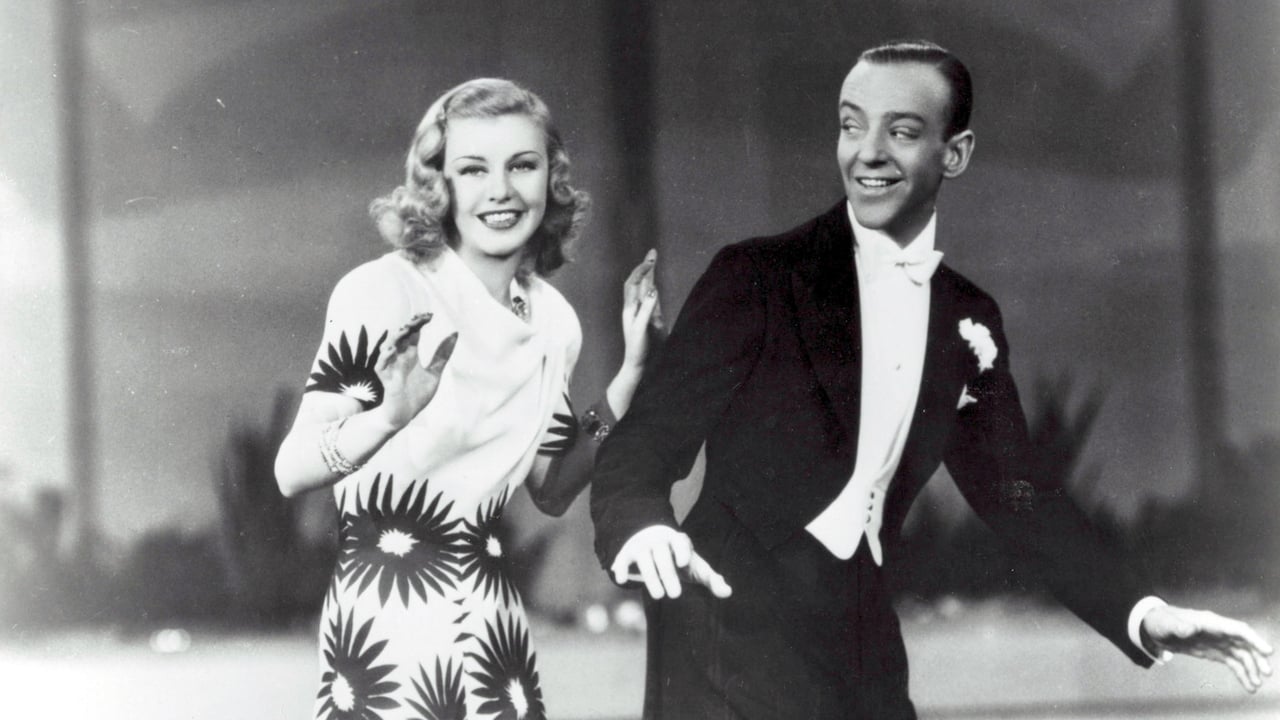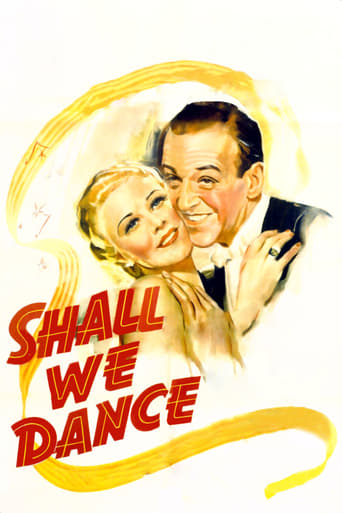

. . . so people who watch SHALL WE DANCE before viewing the MUSIC OF brief "Bonus Feature" on the 2005 Turner DVD will not be surprised to hear that Songster George Gershwin died of a brain tumor within a few months of composing them, or be shocked to listen to a (no doubt partial) list of nine numbers written for but cut from the final version of SHALL WE DANCE. Five people are credited with fashioning the convoluted plot for DANCE, and it would not flabbergast any DANCE watcher to learn that several of THEM also were fighting terminal brain diseases at this time. From the Racially Insensitive early "Petrov" tap routine supposedly taking place among a steamship's Black coal stokers to the finale's title song rip-off of Busby Berkeley's "I've Only Got Eyes for You" piece, DANCE features more misfires than hits. Nearly every note of a healthy George Gershwin's earlier PORGY AND BESS is a triumph, but clearly coming within the orbit of the cadaverous Fred Astaire--who had recently mocked Bill "Bojangles" Robinson IN BLACKFACE, of all things!--hastened the former's demise. Whatever ability Ginger Rogers may have had to be a saving grace for DANCE is greatly diminished by her very limited role here in one of her weakest movie outings.
... View MoreSomewhere I read that you'll think more highly of the Astaire/Rogers SHALL WE DANCE if it's the first of their movies that you've seen. Watching them in order leaves you with the impression that we've seen all this before, and what's more, that we've seen it all done better before as well.Unquestionably the great strength of the film is its musical score, by my count the fifth great musical score in a row for the series, but I'd have to agree with George Gershwin that it wasn't used very well. The main problem: Ginger and Fred don't dance together enough. Indeed, they only have one major duet in the whole movie, danced to 'They All Laughed'. It's a dandy, but even here they'd done comparable dances even more brilliantly in ROBERTA, TOP HAT AND SWING TIME. Of course, they also roller skate, and practically everyone adores the scene so who am I to knock it? Nevertheless, I miss them dancing, and the final duet to the title song comes and goes in about 30 seconds and only whets my appetite for more.After giving possibly the best performance in the entire series in SWING TIME, Ginger Rogers seems off here, irritable practically from beginning to end and considerably less fun than she was in the rest of the series (and during practically the rest of her career). The fact that she was the victim of an extortion attempt during the film's shooting may have had something to do with it. For those interested, she received a note demanding $50,000 or else they would kill Ginger's mother. Turning it over to the FBI, the fellow was apprehended at the scheduled drop point and turned out to be a sailor who was simply after the money, not the mother. He'd chosen Ginger because she was his favorite actress!But getting back to the movie, unlike in the rest of the series the songs are generally ill-fitted into the plot. While it's not unusual for Fred's solo to be a simple exhibition of his dancing ability that has little to do with the rest of the film, it is unusual for their major duets to move the plot exactly nowhere. As John Mueller points out in ASTAIRE DANCES, during the marvelous dance to 'They All Laughed', Ginger's character seems to be loosening up emotionally and moving closer to Fred's, the typical character movement in their up tempo numbers, but here she simply reverts to exactly where she had been before, i.e., simply resentful towards him. It's as if the dance had never happened. And what her motivation was for the reconciliation dance at the end I'll never understand. Would you be attracted to someone dancing with people wearing masks of you? I'd more likely call the nearest mental hospital.Speaking of motivation, what exactly would possess Fred to suddenly play hard to get once Ginger had finally invited him into her apartment on their wedding night? It did lead to probably the most artful shot that Mark Sandrich devised in the entire series (the one of them both hesitating before opposite sides of the door between them), but still...Ah, I'm sure I'm being too hard on SHALL WE DANCE. It's an elaborate production featuring two great performers, a few laughs, and terrific music. Who could ask for anything more?
... View MoreThe big takeaway on Fred Astaire and Ginger Rogers is how well they danced together. My big takeaway from "Shall We Dance" is how well they acted.It's one thing to give a good performance in a musical like "Carousel" or "Singing In The Rain", and quite another to deliver amid the creaky jokes, plummy patter, and contrived plot twists that make up "Shall We Dance". But they do, and thanks to them, the show turns out not only okay but rather fine.Astaire is a faux-Russian ballet dancer, Petrov, who dreams of pairing up with celebrated tap dancer Linda Keene (Rogers) both on-stage and off. Linda just wants to retire, but Petrov's earnestness begins to win her over - until she is led to believe he is using her. She leaves him just as word spreads that the two are married (and really spreads, in the form of front-page news stories and radio flashes), forcing them to face a surreal prospect."We're the only people in the world who don't think we're married!" Linda exclaims.People watching "Shall We Dance" for the first time need patience. Astaire and Rogers don't dance for an hour, their one musical moment all that time involving walking a dog around a ship in time to a musical theme (provided by one George Gershwin, who did the score with his lyricist brother Ira). Matters are too often dominated by Edward Everett Horton's over-the-top eye rolls and leaden asides as Petrov's snooty, disapproving manager. Later on William Brisbane arrives as Linda's rich-guy suitor, adding more overbaked ham to the menu.But Astaire keeps his end up, dancing to a skipping record or later overplaying a mock Russian accent in his first face-to-face with Linda. "You don't want to dance with the great Petrov," he declares, playing up a Slavic superiority trip. "Don't be a silly horse." The way he elongates that last "o" is positively indecent.Some reviewers here say Rogers seems bored in this film. She's playing a withdrawn character, though, and does give off passion when called upon. A big musical moment between her and Astaire, when he declares "They Can't Take That Away From Me", is a remarkable duet despite the fact she doesn't sing a note, just looks off with tear-filled eyes. Yet she gets the song's one close-up, and rightly so. When they have their first performance in front of an audience and he dances up a storm by way of an introduction, the look on her face is priceless. "What am I supposed to do?" she deadpans.Give director Mark Sandrich credit for keeping things light. Too light at times, like when Linda's manager somehow gets a photo of the couple in bed together by using a manikin of her he just happens to have in his closet (better I guess we don't know why he does). Sandrich does make the good scenes better with doses of gentle humor, like the capper to a roller-skating dance that is the movie's best moment. There are some nice dissolves from scene to scene, like a flip-book view of Linda dancing that melts into the real thing.Watching this the first time, the minutes stretched like rubber. The second time things flew much faster, because I knew what I wanted to see and could look forward to its arrival. I guess audiences of the 1930s had that expectation built in, one reason perhaps why these movies were so popular and no one cared when they were a bit inane.
... View MoreIts fun walking through movies from an era where the stage had not yet migrated away from the screen. It was possible, for instance for Fred Astair to be in the funky bowels of a coal- fired ship and have us presented with a polished floor and musically clanking stage engine parts. This sort of stage/reality merger is not possible today, even in "musicals" and its quite a cinematic jolt, even though expected.But supposing you aren't tuned the way I am, there are still three very nice things here. In the order they appear: The story is about a man (a dancer) who sees a picture of a woman (who happens to also be a dancer) and falls in love with her. But her appeal should be something to do with how she dances, right? And pictures don't dance. Ah, but they do; we are shown a flip book, consisting of photos from a film. Flip the pages and you see her dance. Stare a moment and the flipbook seamlessly transforms into the film of her dancing. Its a film within that could as easily from that point be the guy's fantasy. This ability to play fast and loose with reality, film and show is unique, I think, to the 30s. We've come to see Fred and Ginger dance. But we've seen them before, and the truth is that no matter how talented they are, its much the same from one film to the next. So what to do? Well, you add two gimmicks. One is not interesting to me: Fred "mixes" ballet and tap. The other is pretty amazing: Fred and Ginger dancing as a couple on roller skates! Now this is pretty darn amazin'. They both seem to completely understand gravity as visionary mystics. That's what its all about, is transcendence. Its what makes her sexy as heck and he classy. The final big number has two devices that impressed. The first and most visually cinematic is the set. It is a huge cylinder with many vertical doors behind which dancing girls appear and vanish. This is expertly designed and photographed, the only thing here that is. The other device is that the scores of girls wear Ginger masks. She has left him and re-appears behind one of the masks. Oh, you should know that the story, thin as it is, is based on false presentations like this.Ted's Evaluation -- 2 of 3: Has some interesting elements.
... View More